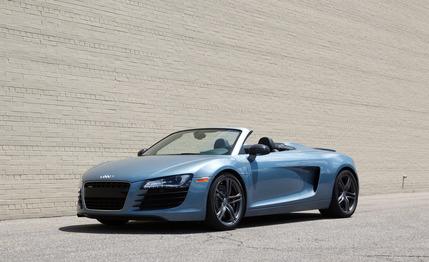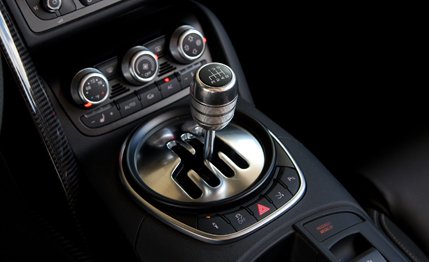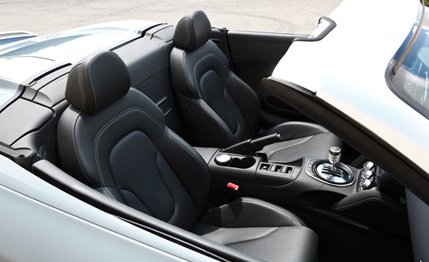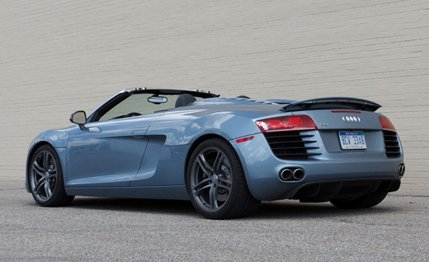
 Short Take Road Test
Short Take Road Test


Public reaction seldom factors into our vehicle reviews, but the response this R8 Spyder elicited was hard to ignore, and it was not only plentiful but uniformly positive. As friendly and approachable as we tend to be—look at that handsome guy in the convertible, they must think—people don’t often toss out unsolicited opinions. But with this R8, smiles and thumbs-ups abounded; it was the ice-cream-truck effect with a better soundtrack.
Take the response of one motorist who reasonably could have been offended by one editor’s assertive on-road maneuver: “[Expletives deleted]! Nice car! [More expletives deleted]!” Or the pickup-truck-driving gentleman who admired the R8 from on high at a stoplight and asked how it was to drive. His next question concerned fuel economy, which we described with an off-guard “um, okay.” (We achieved a 13-mpg average for the test, which is maybe not quite, um, okay.) The light changed, and there was no time to tell him that our carbon-fiber-drenched example cost nearly $160,000 and that folks who could afford it likely wouldn’t worry about such things.
No Compromises, No Alarms, and No Surprises
The R8 Spyder needn’t be judged solely on the ogling and compliments of others. We, too, think the convertible is thoroughly stunning. And just as we found with the V-10 spyder versus its coupe counterpart, removing the roof makes the V-8 sound extra-fantastic to the two people it’s pushing around.


The gated manual’s clack-clack engagement, audible between bursts of V-8 expression, was yet another sensory payoff. We try to avoid clichés, but this shifter deserves the bolt-action descriptor. (It should be noted that the last time we published the phrase was in reference to a rifle.) All three pedals in this R8 were docile and well spaced, making rev-matched heel-and-toe downshifts easy, rewarding, and repeatable. And initial clutch takeup is never jerky, with only the slightest hint of throttle needed to get going in first, at which point the car is happy to trundle along shudder-free in 5-mph traffic.


The V-8 fits the spyder’s relaxed, everyday-use character, as its 430 hp don’t overpower the chassis unless you really want them to. All the controls, including the steering, have a lightness that would seem to be at odds with the R8’s supercar mission, but that simply makes the car easy to live with, not duller.
Even over the worst road divots and lumps, the R8 Spyder rarely trembles. Audi beefed up the cowl and added extra bracing under the floor. To compensate for the weight of the various reinforcements and the top mechanism, Audi uses carbon-fiber pieces for the rear fenders and tonneau. Still, the spyder is more than 300 pounds heavier than the last manual-transmission R8 V-8 coupe we tested.
With the help of the 10-hp bump the V-8 got last year, this spyder posted a 0-to-60-mph time of 4.3 seconds. All R8s now come standard with two-mode magnetorheological dampers. Even with them in sport mode, however, skidpad grip was down a bit versus the coupe’s: 0.93 g compared with 0.97. We’re observing, not complaining. At 156 feet from 70 to 0 mph, the spyder managed to stop in four fewer feet and with more consistency.


More Than One Way to Skin a Carbon Fiber
So maybe there’s one drawback in all of this. R8 coupes offer a pheasant-under-glass engine room that neatly displays the mid-mounted wonder. Here, the two people sitting ahead of the engine are instead on display. The top covers the engine, with only the back half of the powerplant visible when an access-panel hood is flipped up. (The flat rear deck does have one advantage: a rear view that’s largely the same with the top up or stowed.)
This brings us to the resin-impregnated laundry list of carbon-fiber doodads this R8 carried. Chief among the pointless dress-up items is a set of engine-compartment appliqués ($1800) that no one’s ever going to see. Then there are the carbon-fiber mirror caps ($1400), some doorsill pieces ($1050), a swath of interior-trim parts ($2500), and the special-order-only exterior package, which consists of an autoclaved front splitter and rear diffuser ($8100). The grand total, which happens to be the most you can add to the price of an R8 Spyder by way of carbon-fiber extras, is $14,850.
That accounts for more than half of the $28,000 options total on top of this R8’s base price of $131,950. There’s extra leather trim for $5500—we’d actually recommend this one, as it dresses up what is otherwise a somewhat plain cabin that’s starting to show its age and parts-bin roots. Navigation and the Convenience package are $2100 each, the latter consisting of parking sensors, a rearview camera, and some minor items. A Bang & Olufsen sound upgrade is $1800, Jet Blue paint is $650, titanium-finish wheels run $500, contrast stitching for the leather seats costs $250, and a perforated-leather steering wheel is another $250. The $159,950 total is $7000 shy of the price of an optionless V-10 Spyder.


Cost aside, the R8 Spyder is exotic in the most livable way, like a finely tailored suit that you don’t mind throwing in the washer once in a while. We like that, and it seems bystanders do, too. The people have spoken.